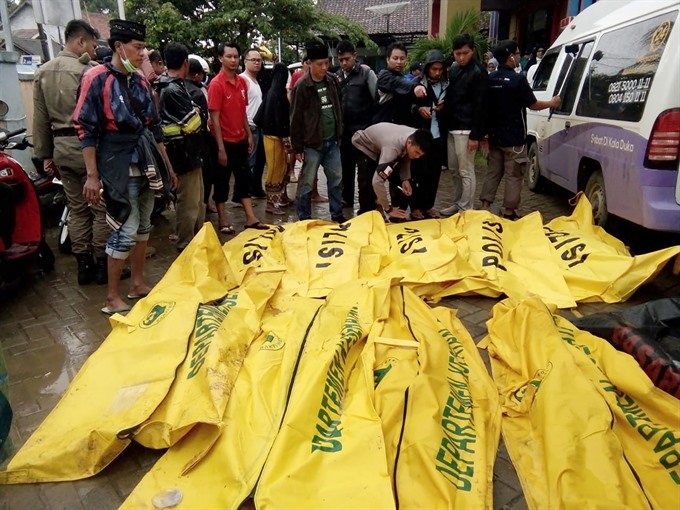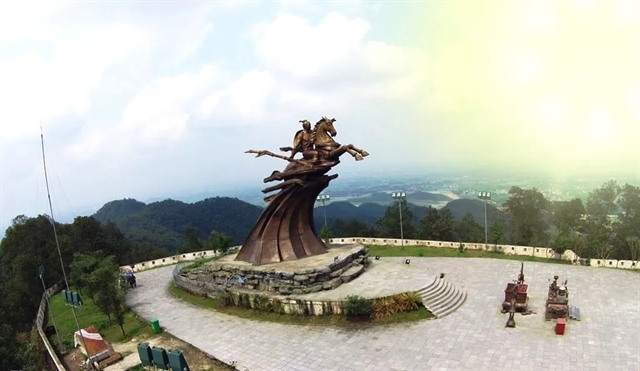 World
World

A volcano-triggered tsunami has left at least 222 people dead and hundreds more injured after slamming without warning into beaches around Indonesia’s Sunda Strait, officials said on Sunday, voicing fears that the toll would rise further.
 |
| Bodies of victims recovered along Carita beach are placed in body bags yesterday after the area was hit by a tsunami on Saturday following an eruption of the Anak Krakatoa volcano. — AFP/VNA Photo |
CARITA — A volcano-triggered tsunami has left at least 222 people dead and hundreds more injured after slamming without warning into beaches around Indonesia’s Sunda Strait, officials said on Sunday, voicing fears that the toll would rise further.
Hundreds of buildings were destroyed by the wave, which hit the coast of southern Sumatra and the western tip of Java about 9.30pm on Saturday after a volcano known as the "child" of Krakatoa erupted, national disaster agency spokesman Sutopo Purwo Nugroho said.
Dramatic video posted on social media showed a wall of water suddenly crashing into a concert by pop group "Seventeen" – hurling band members off the stage and then flooding into the audience.
In a tearful Instagram post, frontman Riefian Fajarsyah said the band’s bassist and road manager had been killed and his wife was missing.
Search and rescue teams were scouring rubble for survivors, with 222 people confirmed dead, 843 people injured and 28 missing, Nugroho said.
Tsunamis triggered by volcanic eruptions are relatively rare, caused by the sudden displacement of water or "slope failure", according to the International Tsunami Information Centre.
Unlike those caused by earthquakes, which trigger alert systems, they give authorities very little time to warn residents of the impending threat.
The destructive wave left a trail of uprooted trees and debris strewn across beaches. A tangled mess of corrugated steel roofing, timber and rubble was dragged inland at Carita beach, a popular spot for day-trippers on the west coast of Java.
Photographer Oystein Andersen described how he was caught up in the disaster while on the beach taking photos of Anak Krakatoa.
"I suddenly saw a big wave," he wrote on his Facebook page.
"I had to run, as the wave passed the beach and landed 15-20m inland. (The) next wave entered the hotel area where I was staying and downed cars on the road behind it."
The International Federation of Red Cross and Red Crescent Societies said the "powerful waves" reached a height of 30-90 centimetres.
Asep Perangkat said he was with his family when the wave surged through Carita, carving a swathe of destruction, dragging cars and shipping containers.
"Buildings on the edge of the beach were destroyed. Trees and electric poles fell to the ground," he said.
In Lampung province, on the other side of the strait, Lutfi Al Rasyid fled the beach in Kalianda city, fearing for his life.
"I could not start my motorbike so I left it and I ran... I just prayed and ran as far as I could," the 23-year-old said.
Kathy Mueller from the International Federation of Red Cross and Red Crescent Societies said the toll was likely to rise as the conditions on the ground became clearer.
"The situation, and the death toll, will remain fluid over the next days and even weeks," she said.
Aid workers were helping to evacuate the injured and bring in clean water, tarpaulins and provide shelter, she added, saying the group was preparing for the possibility of diseases breaking out in the tsunami zone.
Initial error
Anak Krakatoa, which forms a small island in the Sunda Strait between Java and Sumatra, emerged around 1928 in the crater left by Krakatoa, which erupted in 1883 killing at least 36,000 people.
"The cause of the undersea landslide was due to volcanic activity of Anak Krakatoa, which coincided with a high tide due to the full moon," Nugroho told reporters in Yogyakarta.
Professor David Rothery from The Open University said that the proximity of the volcano to the coast gave authorities very little time to act.
"Tsunami warning buoys are positioned to warn of tsunamis originated by earthquakes at underwater tectonic plate boundaries. Even if there had been such a buoy right next to Anak Krakatau, this is so close to the affected shorelines that warning time would have been minimal given the high speeds at which tsunami waves travel," he said.
Indonesian authorities initially said the wave was not a tsunami, but instead a tidal surge and urged the public not to panic.
Nugroho later apologised, saying because there was no earthquake it had been difficult to ascertain the cause of the incident early on.
"If there is an initial error we’re sorry," he wrote on Twitter.
The wave swamped parts of the coast around the Sunda Strait, leaving at least 164 people dead in worst-affected Pandeglang district on Java’s western tip.
Large numbers of casualties were recorded at two hotels in the area, Nugroho said, without elaborating.
Eleven people died further north in Serang, while 48 were killed in South Lampung, on Sumatra island.
Heavy equipment was being transported to badly hit areas to help search for victims and evacuation posts and public kitchens were being set up for evacuees, he added.
No Vietnamese victims reported: embassy
No Vietnamese has been reported dead or missing in the disaster, according to the Embassy of Việt Nam in Indonesia.
The embassy got the information from Indonesia’s Foreign Ministry and advised Vietnamese in Indonesia not to travel to those areas.
The embassy was requested to closely work with local competent agencies to update information and conduct necessary protection measures if any Vietnamese was affected. The embassy should also update information on its portal.
Vietnamese citizens stuck in the region or in need of urgent support are advised to contact the hotline of the Vietnamese Embassy +62811161025 and +62213100358, or the citizen protection hotline +84 981848484.
President, Party General Scretary Nguyễn Phú Trọng and Prime Minister Nguyễn Xuân Phúc yesterday cabled their messages of condolence to Indonesian President Joko Widodo.
National Assembly Chairwoman Nguyễn Thị Kim Ngân sent condolences to the People’s Consultative Assembly of the Republic of Indonesia (MPR) over the disaster.
The same day, Deputy Prime Minister and Foreign Minister Phạm Bình Minh extended his sympathy to Indonesian Foreign Minister Retno Marsudi. — AFP/VNA
 |
| Debris from damaged buildings is seen on a street on Carita beach yesterday after the area was hit by a tsunami on Saturday that was triggered by an eruption of the Anak Krakatoa volcano. — AFP/VNA Photo |




.jpg)